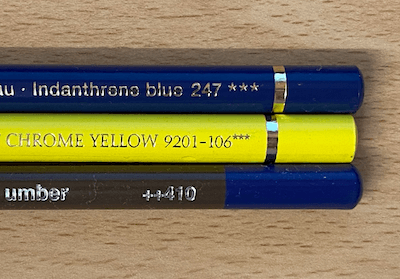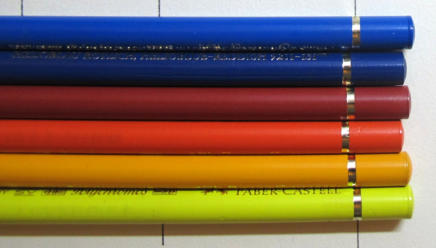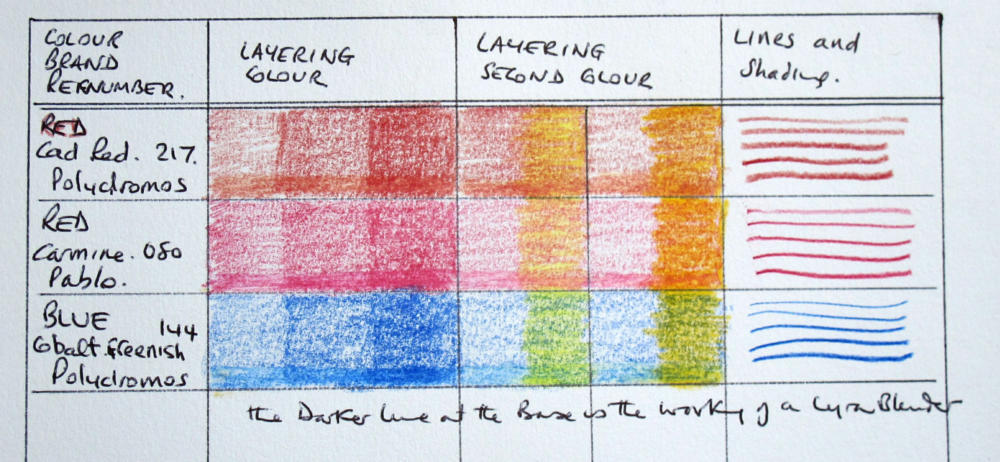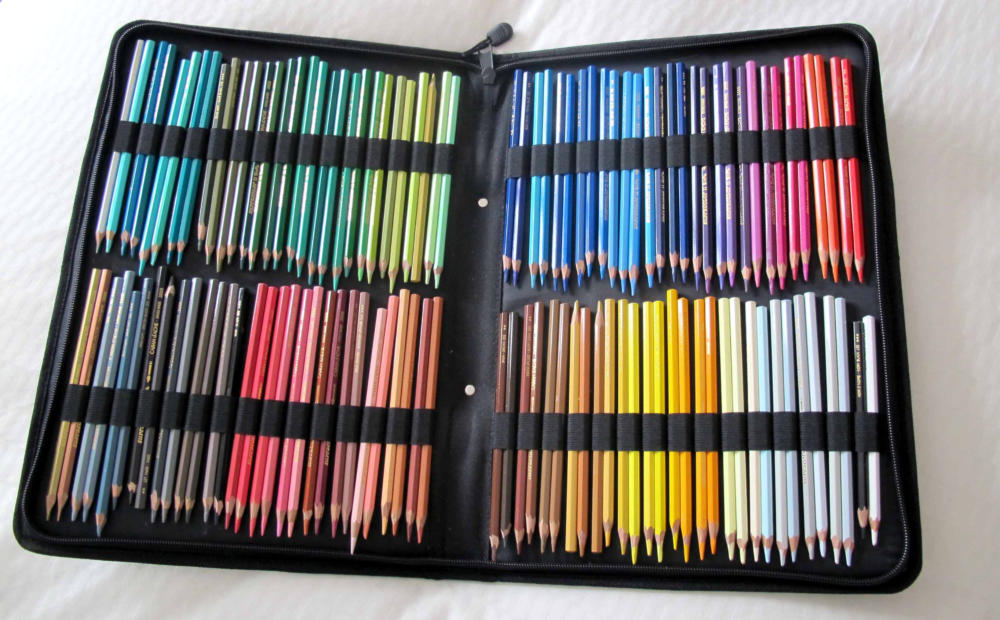- Home
- Pencil brands
- Best Colored Pencils for Artists
Best colored pencils for artists
Ever wondered which are the best colored pencils for artists?
Of course, we all have different needs, so instead of just giving you the answer, let’s work through our testing process here with you. This way, you will see which brand will meet your artistic requirements.
So how can you do your own pencil test?
First, let's consider some pivotal questions.
What type of pencil art do you want to create?
This is significant, as different styles and techniques often require different pencils. Whether you're into realistic portraits or abstract sketches, your choice of pencil can make a world of difference.
Next, consider your budget
Will the cost of the pencil affect your decision? Let's be real. Art supplies can be pricey, but remember, quality often comes at a cost. That said, it is absolutely possible to find excellent pencils that won't break the bank!
Now, think about the brands and ranges you'd like to test
Personally, I've had great experiences with brands like Caran d'Ache and Faber-Castell. They offer a wide range of pencils from student to professional grade, which gives you lots of options.
Do you need a full set to test?
Well, many art supply stores sell individual pencils. This way, you can get a feel for a brand without fully committing.
Once you've answered these questions, you're ready to start your own colored pencil test.
Remember, the best colored pencils for artists can vary. Often it is the one that makes your art feel effortless and brings your imagination to life.
What type of art do you enjoy?
Are you an art enthusiast, a creative hobbyist, or just starting your artistic journey? The world of art is vast and diverse, and the type of pencils you use can significantly influence your artistic outcome.
Suppose you're a 'Colourist,' someone who revels in the joy of breathing life into pre-printed images in colouring books. In that case, you don't need to worry about lightfastness, which is the resilience of pigments against strong light that could fade the colours.
Instead, your focus should be on finding a budget-friendly pencil set with an array of colours. The pencils need to sharpen well and transfer colour to the page with ease. There's no need to splurge on a high-end set just yet - save that money for when you've mastered your skills!
Now, if you're a 'Crafter,' your passion lies in creating cards and small gift pictures. You require pencils that deliver vibrant colours and are hard enough to maintain a fine point for those intricate details on your crafts. A variety of colours will be a bonus, enabling you to play with minimal colour layering and blending. As your crafts may have a shorter lifespan, lightfastness might again not be a top priority.
But what if you're an art 'beginner?' Your journey into the art world should start with a good quality art set that's friendly on the pocket, and has an adequate range of colours.
As you're still exploring your artistic style and needs, it's not advisable to invest heavily in high-end pencils right off the bat. Start with a small to medium set from a reputable manufacturer’s mid-price range, like Faber-Castell or Prismacolor. This will allow you to experiment with blending and layering techniques. As you grow in skill and confidence, you can add more pencils or even buy a second, larger set to supplement your collection.
Are you a seasoned artist moving over to the vibrant world of coloured pencils? You've already found your favourite subjects, whether that's capturing the soulful eyes of a beloved pet, the serene beauty of a landscape, or the intricate details of a still life.
You're well aware of how mixing colours across the colour wheel can create a darkening effect, crafting deeper, richer shades. Perhaps you've even challenged yourself to mix colours from primaries or near primaries, embarking on a thrilling journey of discovery and creativity.
What are the best quality colored pencils?
To discover the best colored pencils for artists like yourself, you'll need a few essentials.
First, you’ll require pencils with reliable pigment levels. Nothing can compare to the thrill of seeing your drawing come alive with bold, vibrant colours. You also need transparency in colours. This allows you to layer colours, creating a sense of depth and dimension that can make your artwork pop.
And let's not forget the importance of a good pencil point and handling. The way a pencil feels in your hand can make all the difference. You need a pencil that glides smoothly across the paper, allowing you to create precise lines and intricate details with ease.
Lightfastness
It's a term we've used a few times and if you're an artist, it's something you need to know about. It's all about your colors staying vibrant, true.
Imagine creating a beautiful masterpiece, investing hours upon hours into that perfect blend of colors, only to have them fade and dull in the blink of an eye. Heartbreaking, isn't it? That's where the concept of lightfastness comes in.
Lightfastness refers to the chemical stability of a pigment under long exposure to light. In amateur terms, it's how resistant a color is to fading when exposed to light. As artists, we want our colors to remain brilliant for years to come. We want our work to stand the test of time, to continue to evoke emotions, and tell stories long after we've put our pencils down.
Now, you're probably wondering, "How do I ensure my colors are lightfast?" Well, it's all in the products you choose. Certain brands prioritize lightfastness in their colored pencils.
For more information on this subject check out the page why is lightfastness important?
When you buy pencils, look for an sign of their lightfast rating. This may be evident in their name, for example, the Derwent Lightfast range, or via a number or symbol on the pencil itself.

Now, it's important to note that highly lightfast sets are sold at a premium price. But, think about it, isn't the longevity of your artwork worth a little extra investment? I believe it is! Besides, the joy of seeing your masterpiece keep its original glory for years is priceless.
If cost is an issue…
…consider this. When you buy a full set of pencils, aren't there always a few colors that just sit there, untouched, gathering dust? You know what I am talking about - those shades that simply do not align with your choice of subjects or your preferred color scheme. They remain unsharpened, unloved, and alas, unused.
Why not then choose to invest in individual pencils that you know you will use? Not only will this ensure that every pencil you buy is a pencil you love, but it also makes economic sense. You're no longer paying for colors you don't need. Plus, it gives you the freedom to build your own custom pencil set, tailored to your artistic needs and preferences.
So what are the best colored pencils for artists?
When comparing different pencil brands, you might think you need to buy their entire color range. But, here's a pro tip—to keep the costs manageable and your palette versatile, I recommend picking just six colors per brand, complemented by a white for blending.
Start with matching hues from varying brands! You'll need two reds, two blues, and two yellows that mirror those depicted in the accompanying image.
Upon a closer inspection, you'll notice the subtle differences in the yellows: one leans towards the orange spectrum, while the other has a greener tint. This distinguishes them as 'warm' and 'cool' colors, respectively.
But wait, it doesn't stop there! The same principle applies to the reds and blues. For each color, you need one warm tone and one cooler shade. If you're scratching your head, wondering how to differentiate between warm and cool shades, check out my page on color theory.
The reason for two of each hue will become apparent once you layer the pencils. Some combinations will produce clear, vibrant mixes while others won’t.

The color testing chart
Don’t worry, this isn’t something to buy. A piece of humble sketchbook paper is all you need.
Start by drawing a series of neat, rectangular boxes. Label each line of boxes. This way, you can easily identify the colors once your chart is complete. Trust me, it's a real lifesaver when you are searching for that perfect shade of sunset orange or ocean blue later on!
I've included a plan below to help you get started, but remember, this chart is only an example. You're the artist, and the way you organize it should reflect the number of pencils you're working with and your unique style.
Don't be afraid to experiment and make it your own.
So here's what we did: in the first column of our color chart, we listed down the details of our pencil - brand, color, and number.
Then comes the exciting part. We filled the adjacent rectangle with a single light layer of pigment, using the named pencil. Soft, subtle, and delicate. An initial impression of what the pencil could do.
But we didn't stop there. We went on and added two more layers of the same color to see how the color intensified.
This simple technique allowed us to see how the color behaves, its opacity, and its ability to layer.

In the second rectangle of each row, we layered a different color from our selection over the original pencil pigment. This is where you will see the difference between the warm and cool colors.
The warm ones are lively and energetic, while the cold ones are calming, soothing, and tranquil. Mixing a warm and cool will give a different effect to mixing two of the same temperature.
You can use the third rectangle as desired. In our test, we wanted to see how fine a line each pencil could create.
Take notes as you go
As you work your way through this exercise, jot down your thoughts and feelings about each brand. For example, I wrote…
- Polychromos colour went down smoothly. Pablo felt as if more pigment was going down for the same pressure.
- The Polychromos point stayed sharp, the Pablo lost its point more quickly.
- I used the lemon yellow (Light Cadmium Yellow) on the first red sample and canary yellow on the second of the Polychromos samples.
- I used lemon yellow and golden yellow Pablo on the Pablo Red
- Both samples would need five or six layers on this paper to get reasonable coverage without blending.
- I ran a line of Lyra clear wax blender across the bottom of each rectangle and it made a substantial difference to colour intensity.
Evaluate the results
The pencil test you’ve just explored will increase your understanding of pencil dynamics, enabling you to compare and contrast between various renowned brands.
Imagine holding a riveting race where the competitors are your top three or four pencil brands, each vying for the title of best colored pencils for artists!
You will now be able to identify your preferred point hardness, marrying precision with durability.
Plus, you'll discover which pencil lays down just the right intensity of color to bring your artistic visions to life. It's like being Goldilocks in an art store - finding the pencil that's 'just right' for you!
Remember, every artist's journey is unique, and the 'perfect' pencil for one may not be the same for another. But that's the beauty of this test—it’s all about discovering what works best for YOU.
For example...
- If you're a botanical artist, you know the importance of hard pencils. They are essential for layering delicate layers of colour, creating intricate details that bring your botanical subjects to life.
- More of a landscape artist? If so, imagine the joy of finding a medium hardness pencil that delivers a strong, vibrant colour. The perfect tool to capture the sweeping vistas, the dramatic contrasts of nature. Suddenly, those rolling hills, soaring mountains, and serene lakes take on a whole extra dimension. You're not just drawing a landscape; you're immersing yourself in it.
- Or maybe you prefer still-life subjects and are searching for a soft pencil to meld your strokes into smooth, glassy surfaces The thrill of watching your art come alive with bold hues, applied with the easy, swift movement of a soft pencil is just what you are looking for in a pencil.
Summing up
In your pursuit of finding the best colored pencils for artists, you have embarked on a journey of self-discovery, exploring the nuances of different brands and their capabilities. Through this pencil test, you have gained insights into how each pencil can bring your imagination to life in its own unique way.
Now armed with this knowledge, it's time to take action. Grab those sketchbook pages and play. Experiment, layer, and blend. Let your creativity flow and your artwork flourish.
But don't stop there. Share your findings with others, spark conversations, and inspire fellow artists to embark on their own pencil tests. Let's create a community of artists who push boundaries, challenge norms, and continuously seek the best tools.


